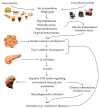Inflammation and Oxidative Stress: The Molecular Connectivity between Insulin Resistance, Obesity, and Alzheimer's Disease
- PMID: 26693205
- PMCID: PMC4674598
- DOI: 10.1155/2015/105828
Inflammation and Oxidative Stress: The Molecular Connectivity between Insulin Resistance, Obesity, and Alzheimer's Disease
Abstract
Type 2 diabetes (T2DM), Alzheimer's disease (AD), and insulin resistance are age-related conditions and increased prevalence is of public concern. Recent research has provided evidence that insulin resistance and impaired insulin signalling may be a contributory factor to the progression of diabetes, dementia, and other neurological disorders. Alzheimer's disease (AD) is the most common subtype of dementia. Reduced release (for T2DM) and decreased action of insulin are central to the development and progression of both T2DM and AD. A literature search was conducted to identify molecular commonalities between obesity, diabetes, and AD. Insulin resistance affects many tissues and organs, either through impaired insulin signalling or through aberrant changes in both glucose and lipid (cholesterol and triacylglycerol) metabolism and concentrations in the blood. Although epidemiological and biological evidence has highlighted an increased incidence of cognitive decline and AD in patients with T2DM, the common molecular basis of cell and tissue dysfunction is rapidly gaining recognition. As a cause or consequence, the chronic inflammatory response and oxidative stress associated with T2DM, amyloid-β (Aβ) protein accumulation, and mitochondrial dysfunction link T2DM and AD.
Figures


References
Publication types
MeSH terms
Substances
LinkOut - more resources
Full Text Sources
Other Literature Sources
Medical
Research Materials

